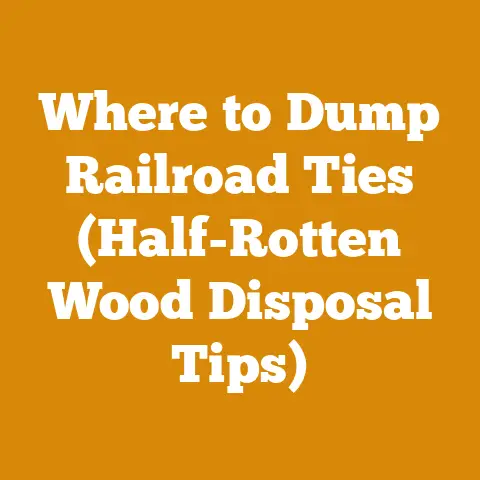Easiest Way to Clean Up Stump Grindings (3 Pro Arborist Tips)
Imagine this: you’ve just spent hours, maybe even days, meticulously grinding down that stubborn tree stump in your yard. The satisfying roar of the stump grinder has finally faded, and you stand back to admire your handiwork. But wait… what’s left is a mountain of wood chips, dirt, and debris – a veritable “stump grinding mess.” Now, how do you tackle this eyesore and reclaim your landscape?
Cleaning up stump grindings is an essential, often overlooked, part of the stump removal process. Leaving them unattended isn’t just unsightly; it can attract pests, harbor diseases, and even create a fire hazard if the wood chips dry out and become easily flammable. As a professional arborist, I’ve dealt with countless stump grinding cleanups, and I’ve learned a few tricks along the way to make the process faster, more efficient, and less back-breaking.
In this guide, I’ll share my top three pro arborist tips for the easiest way to clean up stump grindings. These techniques will not only help you get rid of the mess but also show you how to repurpose the grindings for beneficial uses around your property. So, grab your gloves, and let’s dive in!
Tip #1: Containment is Key: Preventing the Initial Mess
Before you even fire up the stump grinder, planning your cleanup strategy can save you a significant amount of time and effort. Think of it as a pre-emptive strike against the inevitable mountain of grindings.
Understanding Stump Grinding and the Resulting Debris
First, let’s clarify what we’re dealing with. A stump grinder, in essence, is a powerful machine with a rotating cutting wheel equipped with hardened teeth. These teeth chip away at the wood of the stump, reducing it to small pieces – the grindings. These grindings are a mixture of wood chips, soil, and sometimes small rocks or other debris that were embedded in or around the stump. The size and volume of the grindings depend on the size of the stump and the depth to which it was ground.
From my experience, a stump that is 2 feet in diameter, ground down to about 6 inches below the surface, will produce approximately 5 to 7 cubic feet of grindings. This is a substantial amount of material!
Pre-Grinding Preparation for Easier Cleanup
The key to easy cleanup is to minimize the spread of the grindings in the first place. Here’s how:
- Clear the Area: Before grinding, remove any loose objects, plants, or debris surrounding the stump. This includes rocks, branches, and anything else that could get mixed in with the grindings. A clean workspace makes a clean cleanup.
- Erosion Control Blanket/Tarps: This is where the real magic happens. Before you begin grinding, surround the stump with an erosion control blanket or heavy-duty tarps. The goal is to create a barrier that catches the grindings as they are ejected from the grinder. I prefer erosion control blankets because they allow water to pass through, preventing puddling and making it easier to handle the material later. However, tarps are a more economical option.
- Erosion Control Blanket Specifications: I recommend using a biodegradable erosion control blanket made from coconut fiber or straw. These materials are environmentally friendly and will eventually decompose, adding nutrients back to the soil. Look for a blanket that is at least 6 feet wide to provide ample coverage.
- Tarp Specifications: If using tarps, choose heavy-duty polyethylene tarps that are at least 10 mils thick. Lighter tarps are more likely to tear under the weight of the grindings.
- Securing the Barrier: Secure the erosion control blanket or tarps using landscape staples or weights. Make sure the barrier is snug against the ground to prevent grindings from escaping underneath. This is especially important if you are grinding on a slope.
Personal Experience: I once worked on a job where I skipped the tarp step, thinking it would be quicker to just clean up afterward. Big mistake! The grindings were scattered all over the client’s lawn, and it took me twice as long to clean up as it would have if I had simply used a tarp in the first place. Lesson learned: a little preparation goes a long way.
Case Study: The Hillside Stump
I had a challenging project involving a large oak stump located on a steep hillside. The potential for grindings to spread down the slope was significant. I used a combination of techniques to contain the mess. First, I created a series of terraces below the stump using sandbags. Then, I lined each terrace with erosion control blankets. This effectively created a series of “catch basins” that prevented the grindings from spreading down the hill. The result was a much cleaner and more manageable cleanup.
Tip #2: Efficient Removal Techniques: Tools and Methods
Once the grinding is complete, it’s time to remove the debris. This is where the right tools and techniques can make a huge difference.
Tool Selection: Choosing the Right Equipment
- Shovels: A good quality shovel is essential. I recommend a round-point shovel for scooping and a square-point shovel for scraping and leveling.
- Shovel Specifications: Look for shovels with tempered steel blades and durable fiberglass handles. The handle length should be appropriate for your height to prevent back strain.
- Wheelbarrow: A sturdy wheelbarrow is a must for transporting the grindings. Choose a wheelbarrow with a large capacity and pneumatic tires for easy maneuverability.
- Wheelbarrow Specifications: A wheelbarrow with a 6-cubic-foot capacity is a good all-around choice. Pneumatic tires will make it easier to push the wheelbarrow over uneven terrain.
- Landscape Rake: A landscape rake is useful for gathering loose grindings and leveling the area after cleanup.
- Landscape Rake Specifications: Choose a rake with a wide head and flexible tines. A rake with a cushioned grip will be more comfortable to use for extended periods.
- Tractor with Loader (Optional): If you have a large amount of grindings to remove, a tractor with a loader can significantly speed up the process. This is especially useful for commercial operations.
- Tractor Specifications: A compact tractor with a loader capacity of at least 1,000 pounds is sufficient for most stump grinding cleanup tasks.
- Shop Vacuum (Optional): For cleaning up fine dust and debris, a shop vacuum can be helpful.
- Shop Vacuum Specifications: Choose a shop vacuum with a powerful motor and a large capacity. A vacuum with a HEPA filter will prevent dust from being recirculated into the air.
Removal Methods: Step-by-Step Guide
- Gather the Grindings: Using your shovel, carefully scoop the grindings into the wheelbarrow. Be sure to remove any rocks or debris that may be mixed in with the wood chips.
- Transport the Grindings: Push the wheelbarrow to the designated disposal area. This could be a compost pile, a garden bed, or a truck for hauling away.
- Level the Area: Once the bulk of the grindings has been removed, use your landscape rake to level the area. Fill in any holes or depressions and smooth out the surface.
- Remove the Barrier: Carefully remove the erosion control blanket or tarps, being careful not to spill any remaining grindings.
- Final Cleanup: Use your shop vacuum or a broom to clean up any remaining dust or debris.
Personal Experience: I once tried to use a regular garden rake to clean up stump grindings. It was a complete disaster! The tines were too flimsy, and the rake kept getting clogged with wood chips. I quickly realized that a landscape rake is the only tool for the job.
Strategic Considerations for Disposal
The most common disposal options for stump grindings include:
- Composting: Wood chips are a valuable addition to any compost pile. They provide carbon, which helps to balance out the nitrogen-rich materials in your compost.
- Mulching: Stump grindings can be used as mulch around trees, shrubs, and flower beds. They help to retain moisture, suppress weeds, and improve soil health.
- Landfill Disposal: If you cannot use the grindings on your property, you can dispose of them at a local landfill. However, this is the least environmentally friendly option.
- Wood Recycling Centers: Some wood recycling centers will accept stump grindings. Contact your local recycling center to see if they offer this service.
Benefits of Mulching with Stump Grindings:
- Moisture Retention: Wood chips help to retain moisture in the soil, reducing the need for watering.
- Weed Suppression: A layer of wood chips will suppress weed growth, saving you time and effort.
- Soil Improvement: As the wood chips decompose, they add organic matter to the soil, improving its structure and fertility.
- Erosion Control: Wood chips can help to prevent soil erosion, especially on slopes.
Case Study: The Community Garden
I worked with a local community garden to help them clean up a large pile of stump grindings. We used the grindings as mulch around the vegetable beds. The wood chips helped to retain moisture in the soil, which was especially important during the hot summer months. The garden volunteers were also impressed with how effectively the wood chips suppressed weed growth. The result was a healthier, more productive garden.
Tip #3: Optimizing for Repurposing: Turning Waste into Resource
Instead of simply disposing of the stump grindings, consider repurposing them for beneficial uses around your property. This is not only environmentally friendly but can also save you money on landscaping materials.
Understanding Wood Chip Properties: Green vs. Seasoned
Before repurposing stump grindings, it’s important to understand the difference between green and seasoned wood chips.
- Green Wood Chips: These are fresh wood chips that have not yet had a chance to dry out. They contain a high moisture content and are more likely to decompose quickly.
- Seasoned Wood Chips: These are wood chips that have been allowed to dry out for several months. They contain a lower moisture content and are more resistant to decomposition.
Moisture Content Targets:
- Green Wood Chips: Moisture content typically ranges from 30% to 50%.
- Seasoned Wood Chips: Moisture content should be below 20% for optimal use as mulch.
Drying Methods:
- Air Drying: The simplest method is to spread the wood chips out in a thin layer in a sunny, well-ventilated area. Turn the chips regularly to ensure even drying. This process can take several months, depending on the climate.
- Kiln Drying: For faster drying, you can use a kiln. However, this is typically only feasible for commercial operations.
Repurposing Ideas: Creative Uses for Stump Grindings
- Mulch for Gardens and Landscaping: As mentioned earlier, stump grindings make excellent mulch. They help to retain moisture, suppress weeds, and improve soil health.
- Application Guidelines: Apply a 2- to 4-inch layer of wood chips around trees, shrubs, and flower beds. Be sure to keep the mulch away from the base of the plants to prevent rot.
- Compost Material: Wood chips are a valuable addition to any compost pile. They provide carbon, which helps to balance out the nitrogen-rich materials in your compost.
- Composting Tips: Mix the wood chips with other compost materials, such as leaves, grass clippings, and food scraps. Turn the compost pile regularly to ensure proper aeration.
- Pathway Material: Stump grindings can be used to create natural pathways in your garden or yard. They provide a soft, comfortable surface to walk on and help to prevent erosion.
- Pathway Construction: Spread a layer of wood chips over the desired pathway area. Compact the chips with a roller or tamper. Replenish the chips as needed.
- Playground Surfacing: Wood chips can be used as a safe and natural surfacing material for playgrounds. They provide a cushion in case of falls and help to prevent injuries.
- Playground Safety: Use only hardwood chips for playground surfacing. Softwood chips can splinter and pose a safety hazard. The chips should be at least 12 inches deep to provide adequate cushioning.
- Animal Bedding: Stump grindings can be used as bedding for livestock, such as chickens, horses, and cows. They provide a comfortable and absorbent surface for the animals to lie on.
- Animal Health: Use only hardwood chips for animal bedding. Softwood chips can contain toxins that are harmful to animals. The chips should be dry and free of mold.
Personal Experience: I once used stump grindings to create a pathway in my backyard. It was a simple and inexpensive project that completely transformed the look of my yard. The pathway is now a favorite spot for walking and relaxing.
Strategic Advantages of Repurposing
- Environmental Benefits: Repurposing stump grindings reduces waste and conserves resources.
- Cost Savings: Using stump grindings as mulch or compost can save you money on landscaping materials.
- Improved Soil Health: Wood chips add organic matter to the soil, improving its structure and fertility.
- Enhanced Aesthetics: Wood chip pathways and mulched garden beds can enhance the beauty of your property.
Cost Analysis:
- Disposal Costs: Disposing of stump grindings at a landfill can cost anywhere from \$50 to \$100 per cubic yard.
- Mulch Costs: Purchasing mulch from a garden center can cost anywhere from \$30 to \$50 per cubic yard.
- Compost Costs: Purchasing compost from a garden center can cost anywhere from \$40 to \$60 per cubic yard.
By repurposing stump grindings, you can avoid these costs and potentially save hundreds of dollars.
Addressing Common Concerns
- Termites: While termites can be attracted to wood, they are more likely to infest dead wood than living plants. Applying mulch properly (away from the base of plants) and monitoring for termite activity can minimize the risk.
- Soil Acidity: Some wood chips can slightly acidify the soil. However, this is usually not a problem for most plants. If you are concerned about soil acidity, you can add lime to the soil to balance the pH.
- Nitrogen Depletion: As wood chips decompose, they can temporarily deplete nitrogen from the soil. To prevent this, you can add a nitrogen-rich fertilizer to the soil when applying mulch.
Conclusion: Mastering the Art of Stump Grinding Cleanup
Cleaning up stump grindings doesn’t have to be a dreaded chore. By following these three pro arborist tips – containing the mess, using efficient removal techniques, and optimizing for repurposing – you can transform this task into a manageable and even rewarding experience.
Remember, preparation is key. A little planning before you start grinding can save you a lot of time and effort later on. Invest in the right tools and learn the proper techniques for removing and transporting the grindings. And most importantly, consider the many ways you can repurpose the grindings for beneficial uses around your property.
Next Steps for You
Ready to put these tips into practice? Here’s what I recommend:
- Plan Your Next Stump Grinding Project: Before you start grinding, take the time to plan your cleanup strategy. Gather your tools, prepare your barriers, and decide how you will dispose of or repurpose the grindings.
- Experiment with Repurposing: Try using stump grindings as mulch in your garden or as a pathway material in your yard. See how they can enhance the beauty and functionality of your property.
- Share Your Experiences: Share your stump grinding cleanup experiences with others. Let them know what worked for you and what didn’t. Together, we can all learn to make this task easier and more sustainable.
- Continue Learning: The world of arboriculture and wood processing is constantly evolving. Stay up-to-date on the latest tools, techniques, and best practices. Attend workshops, read industry publications, and connect with other professionals in the field.
By embracing these strategies, you can not only conquer the stump grinding mess but also contribute to a more sustainable and beautiful landscape. Now, go forth and transform those grindings into a valuable resource!






